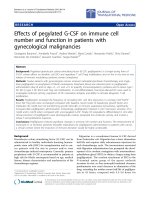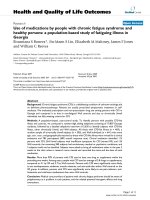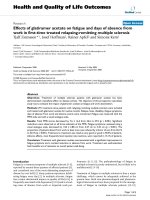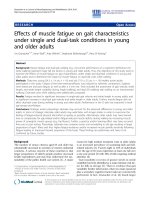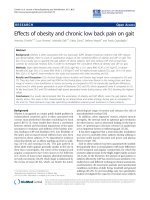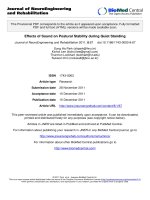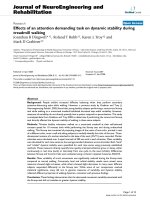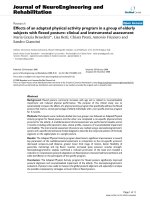Báo cáo hóa học: " Effects of a robot-assisted training of grasp and pronation/supination in chronic stroke: a pilot stud" pot
Bạn đang xem bản rút gọn của tài liệu. Xem và tải ngay bản đầy đủ của tài liệu tại đây (3.72 MB, 33 trang )
This Provisional PDF corresponds to the article as it appeared upon acceptance. Fully formatted
PDF and full text (HTML) versions will be made available soon.
Effects of a robot-assisted training of grasp and pronation/supination in chronic
stroke: a pilot study
Journal of NeuroEngineering and Rehabilitation 2011, 8:63 doi:10.1186/1743-0003-8-63
Olivier Lambercy ()
Ludovic Dovat ()
Hong Yun ()
Seng Kwee Wee ()
Christopher WK Kuah ()
Karen SG Chua ()
Roger Gassert ()
Theodore E Milner ()
Chee Leong Teo ()
Etienne Burdet ()
ISSN 1743-0003
Article type Research
Submission date 14 February 2011
Acceptance date 16 November 2011
Publication date 16 November 2011
Article URL />This peer-reviewed article was published immediately upon acceptance. It can be downloaded,
printed and distributed freely for any purposes (see copyright notice below).
Articles in JNER are listed in PubMed and archived at PubMed Central.
For information about publishing your research in JNER or any BioMed Central journal, go to
/>For information about other BioMed Central publications go to
/>Journal of NeuroEngineering
and Rehabilitation
© 2011 Lambercy et al. ; licensee BioMed Central Ltd.
This is an open access article distributed under the terms of the Creative Commons Attribution License ( />which permits unrestricted use, distribution, and reproduction in any medium, provided the original work is properly cited.
- 1 -
Effects of a robot-assisted training of grasp and
pronation/supination in chronic stroke: a pilot study
Olivier Lambercy
1,2§
, Ludovic Dovat
1
, Hong Yun
3
, Seng Kwee Wee
3
, Christopher
WK Kuah
3
, Karen SG Chua
3
, Roger Gassert
2
, Theodore E Milner
4
, Chee Leong Teo
1
,
and Etienne Burdet
5,1
1
Department of Mechanical Engineering, National University of Singapore,
Singapore, Singapore;
2
Rehabilitation Engineering Lab, ETH Zurich, Zurich, Switzerland;
3
Department of Rehabilitation Medicine, Tan Tock Seng Hospital, Singapore,
Singapore;
4
Department of Kinesiology and Physical Education, McGill University, Montreal,
Canada;
5
Department of Bioengineering, Imperial College of Science, Technology and
Medicine, London, UK.
§
Corresponding author
Email addresses:
OL:
LD:
HY:
SKW:
CWKK:
KSGC:
RG:
TM:
TCL:
EB:
- 2 -
Abstract
Background
Rehabilitation of hand function is challenging, and only few studies have investigated robot-
assisted rehabilitation focusing on distal joints of the upper limb. This paper investigates the
feasibility of using the HapticKnob, a table-top end-effector device, for robot-assisted
rehabilitation of grasping and forearm pronation/supination, two important functions for
activities of daily living involving the hand, and which are often impaired in chronic stroke
patients. It evaluates the effectiveness of this device for improving hand function and the
transfer of improvement to arm function.
Methods
A single group of fifteen chronic stroke patients with impaired arm and hand functions (Fugl-
Meyer motor assessment scale (FM) 10-45/66) participated in a 6-week 3-hours/week
rehabilitation program with the HapticKnob. Outcome measures consisted primarily of the
FM and Motricity Index (MI) and their respective subsections related to distal and proximal
arm function, and were assessed at the beginning, end of treatment and in a 6-weeks follow-
up.
Results
Thirteen subjects successfully completed robot-assisted therapy, with significantly improved
hand and arm motor functions, demonstrated by an average 3.00 points increase on the FM
and 4.55 on the MI at the completion of the therapy (4.85 FM and 6.84 MI six weeks post-
therapy). Improvements were observed both in distal and proximal components of the clinical
scales at the completion of the study (2.00 FM wrist/hand, 2.55 FM shoulder/elbow, 2.23 MI
hand and 4.23 MI shoulder/elbow). In addition, improvements in hand function were
observed, as measured by the Motor Assessment Scale, grip force, and a decrease in arm
muscle spasticity. These results were confirmed by motion data collected by the robot.
- 3 -
Conclusions
The results of this study show the feasibility of this robot-assisted therapy with patients
presenting a large range of impairment levels. A significant homogeneous improvement in
both hand and arm function was observed, which was maintained 6 weeks after end of the
therapy.
- 4 -
Background
Stroke is one of the leading causes of adult disability. While there is strong
evidence that physiotherapy promotes recovery, conventional therapy remains
suboptimal due to limited financial and human resources, and there are many open
questions, e.g. when therapy should be started, how to optimally engage the patient,
what is the best dosage, etc. [1-3]. Furthermore, exercise therapy of the upper limb
has been shown to be only of limited impact on arm function in stroke patients [4].
Robot-assisted rehabilitation can address these shortcomings and complement
traditional rehabilitation strategies. Robots designed to accurately control interaction
forces and progressively adapt assistance/resistance to the patients’ abilities can
record the patient's motion and interaction forces to objectively and precisely quantify
motor performance, monitor progress, and automatically adapt therapy to the patient's
state.
Studies with robots such as the MIT-Manus, the ARM Guide or the MIME have
demonstrated improved proximal arm function after stroke [5-8], although these
improvements did not transfer to the distal arm function which is necessary for most
Activities of Daily Living (ADL) [9-11]. Robot-assisted training which specifically
targets the hand might be required to achieve significant improvements in hand
function. Furthermore, several studies indicate a generalization effect of distal arm
training, e.g. hand and wrist, on proximal arm function, i.e. elbow and shoulder,
which may lead to improved control of the entire arm [10, 12, 13].
We therefore focused on robot-assisted rehabilitation of the hand, adopting a
functional approach based on the combined training of grasping and forearm
pronation/supination, two critical functions for manipulation. This paper presents the
- 5 -
results of a pilot study using the HapticKnob, a portable end-effector based robotic
device to train hand opening/closing and forearm rotation. In contrast to robotic
devices based on exoskeletons attached to the arm [14], the HapticKnob applies
minimal constraints to the different joints of the upper arm, thus corresponding to
situations encountered during ADL. The forearm rests on an adjustable padded
support, while the shoulder and upper arm are not restrained.
The objectives of this pilot study were to determine the feasibility of training
chronic stroke patients with the HapticKnob, and to reduce motor impairment of the
upper limb in a safe and acceptable manner. Although a few studies have investigated
post-stroke rehabilitation of the hand [12, 13], ours is the first to use robot-assisted
training that combines grasp and forearm pronation/supination to perform functional
tasks. With this pilot study, we tested the hypothesis that training the hand using this
functional approach improves function of the entire arm.
Methods
Subjects
Fifteen subjects (55.5±14.6 years, 7 men) with chronic post-stroke hemiparesis,
who were at least 9 months post-stroke (mean 597.5±294.1 days) were recruited for
this study (Table 1). The sample size was limited by the number of patients that could
be enrolled over the duration of the project. Ethical approval was obtained from Tan
Tock Seng Hospital (TTSH) Institutional Review Board before subjects were
approached for screening and informed consent (DSRB A/07/715). Subjects presented
slight to severe residual arm impairment and had completed the initial stroke
rehabilitation program at TTSH. Inclusion criteria were subjects aged between 21 and
85 years with impaired hand opening but capable of partial hand and arm movement
- 6 -
corresponding to proximal upper limb motor power (shoulder-elbow) graded 3-5 out
of 5 on the Oxford Medical Research Council (MRC) scale, distal upper extremity
motor power (wrist-hand) graded 0-3 out of 5 on the MRC scale, and initial Fugl-
Meyer motor assessment scale (FM) for the upper extremity graded between 10-45
points out of 66. Furthermore, subjects should have the ability to understand the
instructions and to perform exercises with the HapticKnob, and to give own consent.
Exclusion criteria were medical or functional contraindications to intensive training,
upper limb pain >4/10 on a Visual Analogue Scale (VAS), upper limb spasticity >2
on the Modified Ashworth Scale (MAS), spastic dystonia or contractures, poor skin
condition over hand and wrist, and visual spatial neglect based on clinical judgment.
The HapticKnob
The HapticKnob [15] is a two degrees-of-freedom (DOF) robotic device used
to train grasping in coordination with pronation/supination of the forearm. These
functions are crucial for object manipulation during ADL, e.g. turning a doorknob,
pouring water into a glass, etc., and are among the distal arm functions stroke subjects
miss the most. The design of the HapticKnob is based on an end-effector approach,
where the robot interacts with the user at the level of the hand (Fig. 1A). It can
generate assistive or resistive forces of up to 50N in both hand opening and closing
and torques of up to 1.5Nm in pronation and supination. While these values are far
from the maximum force/torque a healthy subject can generate (about 450N in
grasping and 20Nm in pronation/supination), they are sufficient to provide
challenging exercises for stroke patients and simulate typical ADL manipulation tasks
[15]. Force sensors (MilliNewton 2N, Thick Film Technology group, EPFL,
Switzerland) are incorporated under each finger support to measure grasping forces of
- 7 -
up to 30N applied on the knob. Fixtures of different size and shape can be attached to
the HapticKnob to train different hand functions such as power grasp, pinch or lateral
pinch. In the study presented in this paper, a disk with a diameter of 6cm was mounted
at the end effector of the robot. During interaction with the robot, various force effects
can be implemented, e.g. to resist or assist the movement, and the range of motion and
force/torque amplitude can be modified to automatically adapt the training parameters
to the user's level of impairment. An adaptable, padded arm support is fixed in front
of the robot. The HapticKnob is controlled using a PC running LabView 8.2 (National
Instruments, USA).
Two simple task-oriented exercises corresponding to typical ADL were
implemented on the HapticKnob. One first objective is to reduce hand impairment,
i.e. spasticity and limited active finger range-of-motion (ROM), by providing passive
assistance similar to stretching [13] for hand opening movements that often are too
difficult for perform. Active force production is promoted to increase muscle strength,
improve control of the impaired limb and facilitate acquisition and retention of skills.
(i) opening/closing exercise, training extension then flexion of the fingers to
simulate grasping of an object. In a first phase of the exercise, the robot opened the
fingers to an extended position adapted to the subject’s range of motion (ROM),
which was selected between 10 and 15 cm from the tip of the thumb to the tip of the
opposing fingers for the subjects of this study. At the end of the opening phase, the
robot maintained the position for three seconds during which subjects were asked to
relax and apply minimal grasping force. An audio signal indicated the beginning of
the closing phase, which required the subject to actively flex the fingers against a
resistive load between 0 to 30N generated by the robot, according to the difficulty
level of the exercise. To train grasping force control, subjects were asked to smoothly
- 8 -
close the hand by following a reference position profile (RPP) displayed on the
monitor (Fig. 1B), which corresponded to a fifth order polynomial defining a minimal
jerk movement between the open and closed positions, as natural movements tend to
follow [16].
(ii) pronation/supination exercise, training forearm rotation and coordination
between grasping and turning required to manipulate knobs [15]. In this exercise,
subjects were asked to supinate or pronate the forearm towards a specific target
orientation, while the linear DOF of the HapticKnob remained in the closed position.
This task required the subjects to produce accurate rotation movements, reach a
[−1°,1°] position window around the target in a minimal time, and remain there for 2
seconds (without exiting). This window was adapted to the human discrimination
threshold in orientation, which is between 0.4−1° [17]. In this study, the amplitude of
forearm rotation was selected between 25° and 45°, corresponding to the subjects’
ROM. In addition, a resistive torque load adapted to the subject’s impairment level
and comprised between 0 and 1Nm was applied by the robot during the exercise in
order to require the subject to hold the knob firmly during the movement.
During training, interactive and intuitive visual feedback was provided to the
subject to promote concentration and motivation. A picture that was stretched in the
open/close exercise and rotated in the pronation/supination exercise (Fig. 1B), in
function of the movement performed with the subject was displayed on the monitor,
while the target position to reach was represented by a white frame. In addition,
exercises were presented as games with a score calculated based on the timing and
precision of the task. This score was provided as feedback to the subject, and used to
adjust the level of difficulty of the task [18]. During each trial, position and force
signals were sampled at a frequency of 100Hz and stored for post-processing.
- 9 -
Training protocol
Robot-assisted therapy consisted of 18 one-hour sessions of training with the
HapticKnob over a period of 6 weeks. Prior to the first therapy session, a preliminary
test session was performed to ensure that subjects were able to interact with the robot
and understood the exercises. All sessions were supervised by an occupational
therapist. Before starting the exercises, 10 minutes were devoted to stretching to
reduce muscle tone and to comfortably position the subject. Each exercise consisted
of 5 sets of 10 trials, lasting about 25 minutes. There was a short rest period between
each set to prevent muscle fatigue and a 5-minute break between the two exercises to
stretch and relax arm muscles (Fig. 1C).
During therapy sessions, subjects sat in an upright position, placed the forearm
on the padded support and grasped the HapticKnob with the hand. The arm support
and the height of the table on which the robot was placed were adjusted to offer the
subject a comfortable position, with the arm resting on the support during the
experiment, the shoulder abducted at 40° and the elbow flexed at 90°. No support was
provided at the level of the proximal arm, so that subjects could position and move
their upper arm freely. Possible compensatory trunk movement or abnormal wrist
hyper-flexion were monitored and manually prevented by the occupational therapist
supervising the therapy. If the subject had difficulty holding the knob, Velcro® bands
were used to prevent fingers and thumb from slipping off the knob.
Robotic outcome measures
Kinematic data collected by the HapticKnob can be used to evaluate motor
performance in the functional tasks trained with the device. To evaluate hand motor
- 10 -
control during the opening/closing exercise, the mean absolute error ε
p
between the
RPP and the position waveform during closing. Motion smoothness was estimated
from the number of zero crossings of the acceleration n
0
(indicating putative velocity
submotions [19]), normalized by the duration of the closing movement. In the
pronation/supination exercise, coordination between grasping and fine forearm
orientation was assessed by the time t
r
required to reach the target window, and the
time t
a
to adjust the angular position once the target is reached for the first time [20].
Robotic data were processed using Matlab R2010a (The MathWorks, Inc.).
Clinical outcome measures
Subjects were assessed at three times during the study: prior to the beginning of
the therapy (week 0), at its completion (week 6), and 6 weeks post-therapy (week 12).
Between week 6 and week 12, patients did not receive any further rehabilitation
therapy focusing on upper extremity motor function. All assessments were done by an
occupational therapist not involved in the HapticKnob training. The primary objective
of the proposed training being to decrease impairment and upper limb improve motor
function, the Fugl-Meyer motor assessment for the upper extremity (FM, range (0-66)
[21]) and the Motricity Index (MI) for motor function of the upper limb were selected
as primary outcome measures. FM scores were subdivided into wrist-hand scores (0-
24), and shoulder-elbow scores including coordination (0-42). MI scores were
converted from raw scores to subscores with a total of 100 points [22]. Similarly to
FM scores, MI scores were subdivided into hand scores (0-33) and shoulder-elbow
scores (0-66).
Secondary outcomes were selected to investigate independent
neurophysiological changes not covered by the primary outcome measures, and
- 11 -
included the Motor Assessment Scale (MS, range (0-18)) to assess everyday motor
function involving the arm and hand [23], the Modified Ashworth Scale as a measure
of spasticity in shoulder abductors, elbow, wrist, finger and thumb flexors (modified
MAS, range (0-5) [24]), the Functional Test of Hemiparetic Upper Extremity
(FTHUE, range (0-7) [25]), the Nine Hole Peg Test (NHPT) [26], and grip force
measurement using a Jamar Grip Dynamometer. Pain was assessed using a Visual
Analog Scale (VAS range (0-10)) and the subject provided a score of satisfaction with
the therapy (1='poor', 2='satisfactory', 3='good' or 4='excellent').
Data analysis
Data were analyzed using SPSS v18 statistical analysis package (IBM). Due to
the small sample size, non-parametric tests were used to investigate differences in
means. Statistical difference was first investigated for each clinical measure using a
two-tailed Friedman test. Bonferroni correction was used to compensate for the two
primary outcome measures of upper limb motor function, so that all tests were applied
using a 0.025 significance level. Post-hoc analysis for possible differences between
baseline discharge and follow-up was then performed using Wilcoxon signed rank
tests (0.05 significance level). For the secondary outcome measures, no Bonferroni
correction was used to correct for the multiple assessments, as these are assumed to be
independent. For the robotic measures, Wilcoxon tests with a 0.05 significance level
were used to investigate differences in means between results of the first and last
training sessions.
Results
All of the 15 post-stroke subjects completed the pilot study, consisting of 18
- 12 -
hours of HapticKnob training over 6 weeks. However, subject A12 had to stop
therapy for a week due to an unrelated fall at home. Further, A11 had severe
concentration problems and suffered from depression Therefore, data from these two
subjects were excluded from the analysis.
Results of primary outcome measures are presented in Table 2. There were
significant increases in FM (Friedman p<0.001) and MI (Friedman p<0.001) scores,
indicating improved upper limb motor function and strength. There were
improvements in proximal and distal subsections of the two primary outcome
measures. These improvements were significant in the distal subportion of the FM
(Friedman p<0.002) and in the proximal subsection of the MI (Friedman p<0.002).
At the end of the robot-assisted therapy (week 6) subjects had improved 3.00
points (+9.3%) on average on the FM scale (p<0.009) with a maximum improvement
of 11 points for subject A9 (Fig. 2). There were improvements in both subportions of
the FM score, with an average increase of 0.92 points (+11.2%, p<0.018) for the
wrist-hand subsection of the FM. Similarly, subjects improved 4.54 points (+9.0%,
p<0.025) on the MI. There was no significant effect of the age group or gender.
Six weeks after completion of the robot-assisted therapy (week 12) the average
gain in FM was 4.85 points (+15.1%, p<0.005). The distal arm showed greater
percentage improvement than the proximal arm during the follow-up period with an
average increase of 2.00 points (+24.3%, p<0.009) compared to 2.85 points (+11.9%).
The results were similar for MI scores, with an average increase of 6.85 points
(+13.5%, p<0.003). Although not statistically significant, distal components of the MI
(i.e. hand-fingers) improved on average by 2.23 points (+17.9%) while proximal
components (i.e. shoulder-elbow) improved by 4.23 points (+11.4%, p<0.011). Figure
3 illustrates the evolution of primary outcome parameters after the 6 weeks of robot-
- 13 -
assisted therapy and the 6-week follow-up.
Table 3 summarizes results for the secondary outcome measures. There was
significant increase in the MS (Friedman p<0.004), indicating a slight improvement in
functional activities involving the arm and hand. There was an average increase of
1.00 point (+24.5%, p<0.010) on the MS scale at the completion of the study. Total
(summed) upper limb spasticity showed an average reduction of 0.92 on the MAS
scale (-11.1%, p>0.117) at week 6. The reduction was 1.23 points at week 12 which
was statistically significant (-14.8%, p<0.019).
In addition, there was a 12.3% gain in grip strength ratio (grip strength of
impaired hand over unimpaired hand) at week 6, though this change was not
significant. There was no significant gain in upper arm function as measured by the
FTHUE, which could be explained by the low sensitivity of this categorical scale, and
the fact that the tasks comprising the FTHUE required a higher level of hand function
than that reached by most subjects. Similarly, only one patient was able to perform the
NHPT, compromising the use of this assessment in the present study.
Minimal pain experienced by two subjects at the beginning of the study
progressively disappeared during the robot-assisted therapy. Therapy with the
HapticKnob was well accepted by stroke patients, and 10 out of 13 (76.9%) subjects
rated their satisfaction post-training as good or excellent.
Figure 4 presents representative trials of the pronation/supination exercise
performed with the HapticKnob for subject A3 over the course of the therapy. A clear
increase in the number of successful trials can be seen; movements become faster and
more precise, the subject reaches the target pronation angle (25°) at each trial during
the last session, while almost no movement was possible in the first session. At the
group level, a clear improvement can be observed, with a significant decrease in all
- 14 -
indicators (Table 4). Subjects improved control of grasping movement as indicated by
a 49.8% decrease in ε
p
, and a 5.1% decrease in n
0
indicative of smoother movements
during the opening/closing exercise. Subjects improved their ability to coordinate
hand and forearm function in order to perform the pronation/supination exercise, with
a 36.6% decrease in the time t
r
to reach the forearm angle, and a 29.6% decrease in
the time to finely tune the position t
a
. This parameter has been shown to be a suitable
indicator of upper limb motor function [20].
Discussion
Fifteen chronic stroke subjects with slight to severe arm and hand impairment
(mean admission FM of 32.15) performed a robot-assisted rehabilitation therapy
program with the HapticKnob involving hand opening/closing and forearm
pronation/supination. Upper limb motor impairment decreased during the treatment
period, as revealed by significant increases in the FM and MI scores, indicating a
noticeable improvement of arm and hand function, together with increased upper
extremity strength. In the literature, a 3-point improvement on the FM scale is often
considered as a minimum impairment change necessary to achieve significant
functional gains [10]. Results of the clinical assessments, which were also confirmed
by analysis of the robot motion data [18], suggest that intensive use of the forearm
and hand in a repetitive robot-assisted training program can improve motor function
in chronic stroke subjects even long after completion of conventional therapy (mean
597.5 days post-stroke). Improvement in the robotic parameters suggests that patients
could learn to perform the tasks and progressively improve their performance,
indicating better hand control and coordination between hand and forearm during the
functional tasks proposed during training with the HapticKnob. Nevertheless, it is not
- 15 -
possible verify whether the improvements observed in the motion data during the
training translate to significant gains in functional activities in daily life.
Improvements in arm and hand function were maintained 6 weeks after the
completion of the therapy, suggesting a stable improvement of the motor condition. In
fact, the primary outcome measures increased further during the 6 weeks after the
therapy. The reduction in arm and hand spasticity (although not statistically
significant when individual arm components were analyzed) could have facilitated
increased use of the impaired hand to perform daily tasks, as could the reduction in
pain levels in the two subjects who initially presented with minimal pain. Robot-
assisted training may have helped pass a threshold of spontaneous arm use where
ADL tasks involving arm and hand are performed at home, thus leading to additional
improvement in upper limb motor function and decreasing learned non-use of the
affected limb [27]. Subjects reported improvement in ADL at home at the end of the
therapy. However, improvements in ADL tasks were not confirmed by corresponding
clinical outcome measures, which is also observed in most robot-assisted studies [28].
Changes in fine hand function could not be captured by the NHPT as most patients
were unable to complete this dexterity test. A different test such as the Box and Block
test [29] should be considered as outcome measure of hand function in future studies.
All 15 chronic stroke subjects were capable of training with the proposed
protocol in a safe manner, without experiencing any complication related to the use of
the robot, and with significant improvement of motor function in their hand and arm.
These results demonstrate the feasibility of using the HapticKnob as a rehabilitation
tool for chronic stroke patients with a large range of sensorimotor deficits. These
results are consistent with results obtained in other robot-assisted studies on upper
limb rehabilitation of chronic stroke patients, where improvements of 3.0 to 7.6 points
- 16 -
in the FM were found [7, 10, 11, 13, 14, 30]. However, there is a lack of comparison
groups for hand rehabilitation, and the variation in improvement between these
studies can be attributed to the differences in experimental protocols, such as intensity
and duration of therapy, as well as to initial motor impairment of the stroke subjects
involved in the study. In contrast to the devices used in previous studies, the
HapticKnob is a compact system that could easily be transported and placed in
hospitals and homes. It requires only minimal function to place the hand on the robot
and thereby makes it accessible to a wide range of subjects, right or left handed, and
with various levels of physical impairment, e.g., an initial FM score lower than 15, as
demonstrated by this study.
It is likely that the severity of motor impairment is a key factor in rehabilitation
outcomes and in the choice of a rehabilitation protocol. Severely impaired subjects
may require longer or more intensive therapy to first strengthen the muscles, decrease
spasticity and reduce other impairments that limit their performance so as to focus on
the restoration of neuromotor pathways without introducing additional complex tasks
[31]. In our study, a larger increase in functional assessment scores during therapy
was observed in subjects initially with moderate impairment (FM>35), suggesting that
subjects already having some motor function of the arm and hand benefit more from
the functional hand therapy with the HapticKnob. Nevertheless, this difference
between moderately and more severely impaired patients was not statistically
significant.
In previous studies, improvement in elbow and shoulder function after training
involving these proximal segments did not seem to transfer to the wrist or hand [9-
11]. In contrast, the results obtained with the HapticKnob indicate that training
involving only distal segments of the arm could lead to improvements in both the
- 17 -
proximal and distal subsections of the primary outcome measures. Improvement was
significant in the hand/wrist subsection of the FM, but not in the shoulder/elbow
section after Bonferroni correction. On the other hand, a significant increase was
observed in the shoulder/elbow component of the MI, but not in the hand component
of MI. Explanations for these seemingly conflicting results include the fact that the
distal component of the MI assesses thumb/finger function rather than wrist/hand
function and the limited number of subjects included in the study. Nevertheless, a
clear positive trend can be observed in all subsections of the two scales, which is
confirmed by the secondary outcome measures, with improvement in both arm and
hand functional tasks as measured by the MS, and reduced spasticity in all of the arm
segments, with the greatest reduction for shoulder abductors and elbow flexors.
These findings support the hypothesis that exercising distal joints of the arm
may benefit the proximal joints [10, 13, 32, 33]. As the arm was not fixed but only
supported, this effect may be due to a recruitment of all arm segments in a task-
oriented way to promote restoration of motor function of the entire arm. In fact, the
pronation/supination exercise trains coordination between fingers, wrist and forearm,
as subjects are required to firmly grasp the handle and then rotate it and also requires
stabilization of the upper arm. Also, distal training requires activation of nerves and
muscles that control each segment of the upper limb, and will thus result in proximal
as well as distal muscle activity. This is partly because some muscles like the biceps
are multi-functional, e.g. supinating the forearm and flexing the elbow and shoulder
whereas others are needed to stabilize the more proximal joints even when the
forearm is supported. Alternatively, patients may have developed compensatory
strategies to achieve forearm pronation/supination with their shoulder, which could
account for part of the increase of MI and FM scores. This effect may be monitored in
- 18 -
future studies. Finally, these results should be interpreted with caution, as no control
group receiving dose-matched conventional or robotic training focusing on the
proximal arm segment was included in the study design. Further limitations of the
current study include single baseline measure, and absence of a long-term follow-up,
which will be considered in future clinical studies.
Conclusions
The results of this pilot study suggest that upper limb robot-assisted
rehabilitation, which currently focuses primarily on training elbow and shoulder
movement, would advantageously include training of the hand and fingers, which can
be provided using compact desktop robots such as the HapticKnob. Whole-arm
training, which is a commonly used approach in robot-assisted neurorehabilitation,
may not be required, as distal training in a functional way could benefit the whole
arm.
- 19 -
Competing interests
The authors declare that they have no competing interests
Authors' contributions
RG contributed to the design and development of the HapticKnob and of the
experimental protocol. TM, TCL and EB also contributed to the data analysis, and
preparation of the manuscript. LD further participated to the clinical evaluation of the
HapticKnob, while OL contributed to all of these aspects, supervised the robot-
assisted therapy at Tan Tock Seng Hospital (TTSH) Rehabilitation center, and
prepared the manuscript. HY, SKW, CWKK and KSGC recruited and assessed
participants to the clinical study and co-supervised the robot-assisted therapy at
TTSH. All authors read and approved the final manuscript.
Acknowledgements
This project was funded in part by a grant from NUS (R265-000-168-112), the
FP7 HUMOUR project and the NCCR Neural Plasticity and Repair, Swiss National
Science Foundation.
- 20 -
References
1. Barreca S, Wolf S, Fasoli S, Bohannon R: Treatment Interventions for the
paretic upper limb of stroke survivors: acritical review. Neurorehabil
Neural Repair 2003, 17:220-226.
2. van Der Lee J, Snels I, Beckerman H, Lankhorst G, Wagenaar R, Bouter L:
Exercise therapy for arm function in stroke patients: a systematic review
of randomized controlled trials. Clin Rehabil 2001, 15:20-31.
3. Winstein C, Wing A, Withall J: Motor control and learning principles for
rehabilitation of upper limb movements after brain injury. In Handbook
of Neuropsychology. Volume 9. 2nd Edition edition. Edited by Grafman J:
Elsevier Health Sciences; 2003: 77-137
4. Teasell RW, Foley NC, Bhogal SK, Speechley MR: An evidence-based
review of stroke rehabilitation. Top Stroke Rehabil 2003, 10:39-58.
5. Hogan N, Krebs HI, Sharon A, Charnnarong J: Interactive robotic therapist.
US patent 5466213, 1995.
6. Reinkensmeyer DJ, Emken JL, Cramer SC: Robotics, motor learning, and
neurologic recovery. Annu Rev Biomed Eng 2004, 6:497-525.
7. Lum PS, Burgar CG, Shor PC, Majmundar M, Van der Loos M: Robot-
assisted movement training compared with conventional therapy
techniques for the rehabilitation of upper-limb motor function after
stroke. Arch Phys Med Rehabil 2002, 83:952-959.
8. Kwakkel G, Kollen BJ, Krebs HI: Effects of robot-assisted therapy on
upper limb recovery after stroke: a systematic review. Neurorehab Neural
Repair 2008, 22:111-121.
- 21 -
9. Volpe BT, Krebs HI, Hogan N, Edelstein OL, Diels C, Aisen M: A novel
approach to stroke rehabilitation: robot-aided sensorimotor stimulation.
Neurology 2000, 54:1938-1944.
10. Krebs HI, Volpe BT, Williams D, Celestino J, Charles SK, Lynch D, Hogan
N: Robot-aided neurorehabilitation: A robot for wrist rehabilitation.
IEEE T Neur Sys Reh 2007, 15:327-335.
11. Volpe BT, Lynch D, Rykman-Berland A, Ferraro M, Galgano M, Hogan N,
Krebs HI: Intensive sensorimotor arm training mediated by therapist or
robot improves hemiparesis in patients with chronic stroke. Neurorehab
Neural Repair 2008, 22:305-310.
12. Hesse S, Werner C, Pohl M, Rueckriem S, Mehrholz J, Lingnau ML:
Computerized arm training improves the motor control of the severely
affected arm after stroke - A single-blinded randomized trial in two
centers. Stroke 2005, 36:1960-1966.
13. Takahashi CD, Der-Yeghiaian L, Le V, Motiwala RR, Cramer SC: Robot-
based hand motor therapy after stroke. Brain 2008, 131:425-437.
14. Nef T, Mihelj M, Kiefer G, Perndl C, Mueller R, Riener R: ARMin -
Exoskeleton for arm therapy in stroke patients. 2007 IEEE 10th
International Conference on Rehabilitation Robotics, Vols 1 and 2 2007:68-
74.
15. Lambercy O, Dovat L, Gassert R, Burdet E, Teo CL, Milner T: A haptic knob
for rehabilitation of hand function. IEEE T Neur Sys Reh 2007, 15:356-366.
16. Krylow AM,Rymer WZ: Role of intrinsic muscle properties in producing
smooth movements. IEEE Trans Biomed Eng 1997, 44:165-176.
- 22 -
17. Vasquez P, Cano M, Acuna C: Discrimination of line orientation in
humans and monkeys. J Neurophysiol 2000, 83:2639-2648.
18. Lambercy O, Dovat L, Yun H, Wee SK, Kuah C, Chua K, Gassert R, Milner
TE, Teo CL, Burdet E: Exercises for rehabilitation and assessment of hand
motor function with the Haptic Knob. 2009 3rd i-CREATe Conference
2009:74-78.
19. Burdet E, Milner TE: Quantization of human motions and learning of
accurate movements. Biol Cybern 1998, 78:307-318.
20. Lambercy O, Dovat L, Yun H, Wee SK, Kuah C, Chua K, Gassert R, Milner
T, Teo CL, Burdet E: Robotic Assessment of Hand Function with the
HapticKnob. Proc 4th International Convention for Rehabilitation
Engineering & Assistive Technology (i-CREATe) 2010.
21. Fugl-Meyer AR, Jaasko L, Leyman I, Olsson S, Steglind S: The post-stroke
hemiplegic patient: A method for evaluation of physical performance.
Scand J Rehabil Med 1975, 7:13-31.
22. Collin C, Wade D: Assessing motor impairment after stroke: a pilot
reliability study. J Neurol Neurosurg Psychiatry 1990, 53:576-579.
23. Carr JH, Shepherd RB, Nordholm L, Lynne D: Investigation of a new motor
assessment scale for stroke patients. Phys Ther 1985, 65:175-180.
24. Bohannon RW, Smith MB: Interrater reliability of a modified Ashworth
scale of muscle spasticity. Phys Ther 1987, 67:206-207.
25. Wilson DJ, Baker LL, Craddock JA: Functional test for the hemiparetic
upper extremity. Am J Occup Ther 1984, 38:159-164.
- 23 -
26. Grice KO, Vogel KA, Le V, Mitchell A, Muniz S, Vollmer MA: Adult norms
for a commercially available nine hole peg test for finger dexterity.
American Journal of Occupational Therapy 2003, 57:570-573.
27. Schweighofer N, Han CE, Wolf SL, Arbib MA, Winstein CJ: A Functional
Threshold for Long-Term Use of Hand and Arm Function Can Be
Determined: Predictions From a Computational Model and Supporting
Data From the Extremity Constraint-Induced Therapy Evaluation
(EXCITE) Trial. Physical Therapy 2009, 89:1327-1336.
28. Mehrholz J, Platz T, Kugler J, Pohl M: Electromechanical and robot-
assisted arm training for improving arm function and activities of daily
living after stroke. Cochrane Database Syst Rev 2008:CD006876.
29. Mathiowetz V, Volland G, Kashman N, Weber K: Adult norms for the Box
and Block Test of manual dexterity. Am J Occup Ther 1985, 39:386-391.
30. Fasoli SE, Krebs HI, Stein J, Frontera WR, Hughes R, Hogan N: Robotic
therapy for chronic motor impairments after stroke: Follow-up results.
Arch Phys Med Rehab 2004, 85:1106-1111.
31. Fasoli SE, Krebs HI, Hughes R, Stein J, Hogan N: Functionally-based
rehabilitation: Benefit or buzzword? 2005 IEEE 9th International
Conference on Rehabilitation Robotics 2005:223-226.
32. Butefisch C, Hummelsheim H, Denzler P, Mauritz KH: Repetitive training of
isolated movements improves the outcome of motor rehabilitation of the
centrally paretic hand. J Neurol Sci 1995, 130:59-68.
33. Carey JR, Kimberley TJ, Lewis SM, Auerbach EJ, Dorsey L, Rundquist P,
Ugurbil K: Analysis of fMRI and finger tracking training in subjects with
chronic stroke. Brain 2002, 125:773-788.
- 24 -
Figure legends
Figure 1 - The HapticKnob robot and the proposed therapy protocol.
A: Stroke subject training on the HapticKnob. B: Visual feedback of the
opening/closing (left) and pronation/supination (right) exercises, where subjects have
to squeeze, respectively orient the picture into a white frame by grasping, respectively
turning the HapticKnob. C: Details of therapy and session protocol.
Figure 2 – Results of the Fugl-Meyer scores for the upper extremity
Comparison of Fugl-Meyer (FM) scores for the upper extremity between
week0/week6, and week0/week12. Circles represent results of the 13 participants
included in the data analysis, squares represent the mean over the 13 subjects, and
crosses represent results of subjects A11 and A12, who had a break in the treatment
and were thus excluded from the analysis. Dashed lines illustrate a 3-point
improvement on the FM considered as a functionally meaningful improvement [10].
Figure 3 – Primary outcome measures
Evolution of Fugl-Meyer (FM) scores for the upper extremity and Motricity Index
(MI) scores for the 13 subjects that were retained for data analysis (mean±std), with
details of sections related to the lower and upper arm (*p<0.05).
Figure 4 – Example of robotic data collected by the HapticKnob
Evolution of pronation movements for patient A3 over the course of the therapy at
sessions 1, 4, 8, 12, 16 and 18, each line representing one trial. The target angular
position window is represented by horizontal dashed lines. Details of parameters
extracted from the kinematic data are given in the lower left plot for one successful
trial; t
r
is the time required to reach the target window for the first time, and t
a
is the
time required to finely adjust the forearm position.
